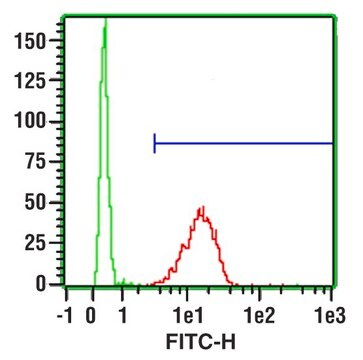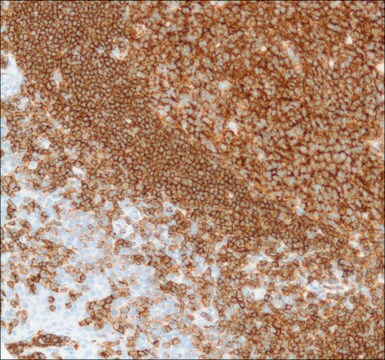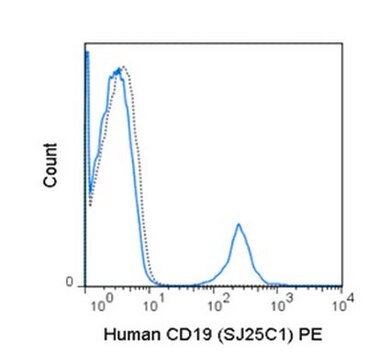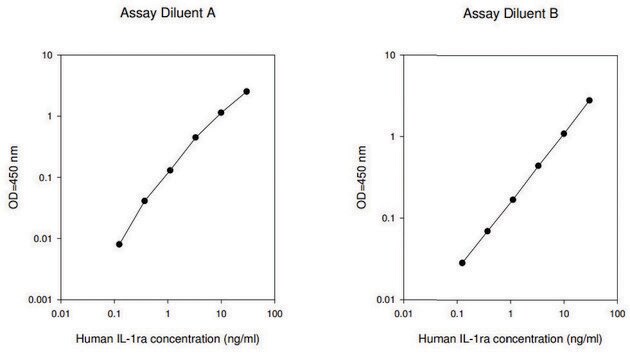SAB4700112
Monoclonal Anti-CD19-FITC antibody produced in mouse
clone LT19, purified immunoglobulin, buffered aqueous solution
Se connecterpour consulter vos tarifs contractuels et ceux de votre entreprise/organisme
About This Item
Code UNSPSC :
12352203
Nomenclature NACRES :
NA.44
Produits recommandés
Source biologique
mouse
Niveau de qualité
Conjugué
FITC conjugate
Forme d'anticorps
purified immunoglobulin
Type de produit anticorps
primary antibodies
Clone
LT19, monoclonal
Forme
buffered aqueous solution
Espèces réactives
human
Technique(s)
flow cytometry: suitable
Isotype
IgG1
Numéro d'accès NCBI
Numéro d'accès UniProt
Conditions d'expédition
wet ice
Température de stockage
2-8°C
Modification post-traductionnelle de la cible
unmodified
Informations sur le gène
human ... CD19(930)
Description générale
The antibody LT19 reacts with CD19 (B4), a 95 kDa type I transmembrane glycoprotein (immunoglobulin superfamily) expressed on B lymphocytes and follicular dendritic cells; it is lost on plasma cells.
Immunogène
Daudi human Burkitt lymphoma cell line
Application
The reagent is designed for Flow Cytometry analysis of human blood cells using 20 μL reagent / 100 μL of whole blood or 1e6 cells in a suspension. The content of a vial (2 mL) is sufficient for 100 tests.
Caractéristiques et avantages
Evaluate our antibodies with complete peace of mind. If the antibody does not perform in your application, we will issue a full credit or replacement antibody. Learn more.
Forme physique
Solution in phosphate buffered saline containing 15 mM sodium azide and 0.2% high-grade protease free BSA as a stabilizing agent.
Clause de non-responsabilité
Unless otherwise stated in our catalog or other company documentation accompanying the product(s), our products are intended for research use only and are not to be used for any other purpose, which includes but is not limited to, unauthorized commercial uses, in vitro diagnostic uses, ex vivo or in vivo therapeutic uses or any type of consumption or application to humans or animals.
Vous ne trouvez pas le bon produit ?
Essayez notre Outil de sélection de produits.
Code de la classe de stockage
10 - Combustible liquids
Classe de danger pour l'eau (WGK)
WGK 2
Point d'éclair (°F)
Not applicable
Point d'éclair (°C)
Not applicable
Faites votre choix parmi les versions les plus récentes :
Déjà en possession de ce produit ?
Retrouvez la documentation relative aux produits que vous avez récemment achetés dans la Bibliothèque de documents.
Carrie E Gifford et al.
Cytometry. Part B, Clinical cytometry, 86(4), 263-271 (2014-03-13)
X-linked lymphoproliferative disease is caused by mutations in two genes, SH2D1A and XIAP/BIRC4. Flow cytometric methods have been developed to detect the gene products, SAP and XIAP. However, there is no literature describing the accuracy of flow cytometric screening performed
I Pizzitola et al.
Leukemia, 28(8), 1596-1605 (2014-02-08)
As significant numbers of acute myeloid leukemia (AML) patients are still refractory to conventional therapies or experience relapse, immunotherapy using T cells expressing chimeric antigen receptors (CARs) might represent a valid treatment option. AML cells frequently overexpress the myeloid antigens
Chung-Wu Lin et al.
Blood, 106(10), 3567-3574 (2005-07-28)
Most lymphoblastic lymphomas (LBLs) are regarded as neoplasms of immature T cells because they express cytoplasmic CD3 and frequently carry T-cell receptor (TCR) gene rearrangements. Immature natural killer (NK) and T cells, however, have a common bipotent T/NK-cell precursor in
J Pieper et al.
Scandinavian journal of immunology, 79(2), 149-155 (2013-12-10)
Proinflammatory CD4(+) CD28(null) T cells are frequently found in the circulation of patients with rheumatoid arthritis (RA), but are less common in the rheumatic joint. In the present study, we sought to identify functional differences between CD4(+) CD28(null) T cells
Notre équipe de scientifiques dispose d'une expérience dans tous les secteurs de la recherche, notamment en sciences de la vie, science des matériaux, synthèse chimique, chromatographie, analyse et dans de nombreux autres domaines..
Contacter notre Service technique







